本文大量内容摘自Preethi Kasireddy的《The Architecture of a Web 3.0 application》一文,并添加了我的解读。
Much of this paper is taken from Preethi Kasireddy's article The Arbitration of a Web 3.0 application, and my interpretation has been added.
感兴趣的同学可以去阅读原文:
Interested students can read the original text:
https://www.preethikasireddy.com/post/the-architecture-of-a-web-3-0-application
在讲Web 3.0应用架构之前,我们需要先了解一下Web 2.0。
Before talking about the Web 3.0 application, we need to know about Web 2.0.
一个典型的Web 2.0应用,例如一个博客应用,通常包含3个部分:
A typical Web 2.0 application, such as a blog application, usually consists of three parts:
这个系统用于存储博客应用的重要数据,例如用户、文章、标签、评论等等,构成了一个数据持续更新的数据库。
The system, which is used to store important data for blog applications, such as users, articles, labels, reviews, etc., constitutes a database for continuous updating of data.
后端代码用于定义博客应用的业务逻辑,例如注册用户,发表文章,发布评论等等。
Backend codes are used to define business logic applied to blogs, such as registering users, publishing articles, publishing comments, etc.
前端代码则是博客应用的用户界面(UI)逻辑,包括博客的外在表现,以及如何与用户进行交互。
The front-end code is the user interface (UI) logic applied by the blog, including the external performance of the blog and how to interact with the user.
总结一下,我们使用一个博客应用时,我们与它的前端代码进行交互,然后前端代码再与后端代码交互,而后端再与数据库进行交互。
To sum up, when we use a blog application, we interact with its front-end code, then the front-end code interacts with the back-end code, and then the back-end interacts with the database.
博客应用的这些代码被部署在中心化的服务器上,然后其他用户通过浏览器来访问。
The codes applied by the blog are deployed on the centralised server , which is then accessed by other users through browsers.
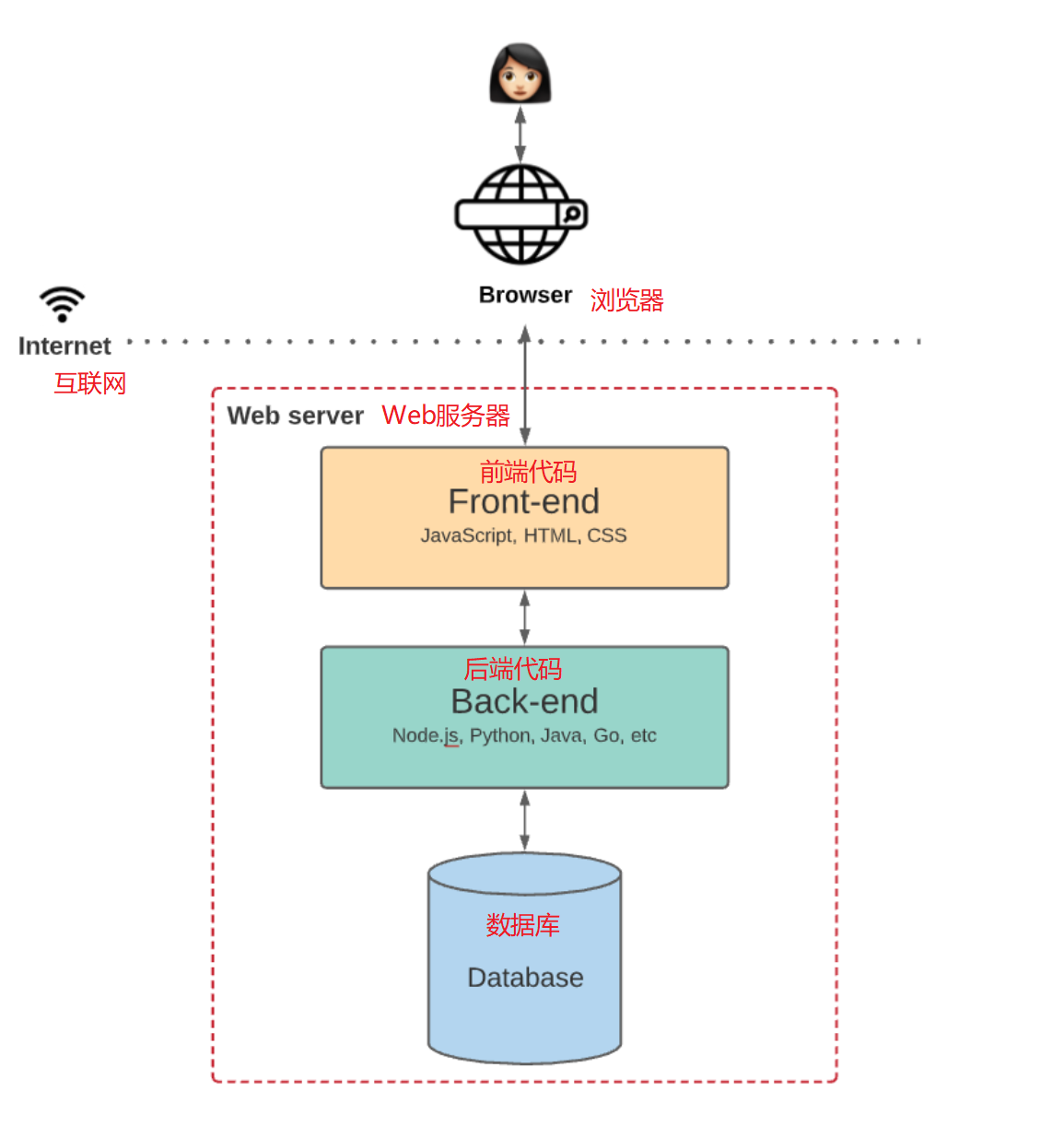
但是,区块链技术为Web3.0解锁了一个全新的方向。
However, block chain technology unlocks a completely new direction for Web3.0.
Web 2.0 的应用需要部署在中心化的服务器上。以博客为例,原文举的例子是Meidum,例如新浪博客(或者其他程序员们熟悉的各种技术博客),或者微信朋友圈,QQ空间等,他们所部署的服务器,都属于某个实体公司或者组织,如新浪或者腾讯,这就是所谓的中心化服务器。
Web 2.0 applications need to be deployed on a centralized server. For example, blogs give the example of Meidum, a new wave blog (or a variety of technology blogs that other programmers are familiar with), or micro-friendship circles, QQ spaces, etc., where the servers they deploy belong to an entity company or organization, such as a new wave or evangelization, which is the so-called `strong' centralization
而Web 3.0消除了这个中间人的必要性,不再需要中心化数据库来存储应用的数据和状态,也不需要中心化的Web服务器来运行前端和后端代码。
Web 3.0 eliminates the need for this intermediary to have a centralized database to store the data and state of application and a centralized Web server to run the front and back end codes.
取而代之,我们可以使用区块链技术,在由无数匿名节点组成的非中心化状态机上,搭建各种应用。
Instead, we can use block chain technology to build applications on the
这里的状态机,指的是用于维护程序状态和状态变化规则的机器。区块链,就是由这样的状态机组成的。
The state machine here is the machine used to maintain the program's state and state change rules. The block chain is made up of this state machine.
这些状态机,由网络上的所有人一起共同维护,不属于任何一个实体,所以是非中心化的。
These state machines, which are jointly maintained by everyone on the network, do not belong to any single entity and are therefore decentralised.
Web 3.0的后端代码,也就是应用的业务逻辑,通过编写智能合约(Smart Contract),然后部署到这些非中心化的状态机上来实现。任何人都可以写一个区块链应用然后部署到这些共享的非中心化状态机上。
The web 3.0 backend code, the business logic applied, is done by writing a smart contract (Smart Contracting) and then deploying to these non-centralised state machines. Anyone can write a block chain application and then deploy to these shared non-central state machines.
所以,先不考虑前端代码的情况下,Web 3.0应用的架构就变成这样子:
So, without considering the front-end code, the structure of the Web 3.0 application becomes this:
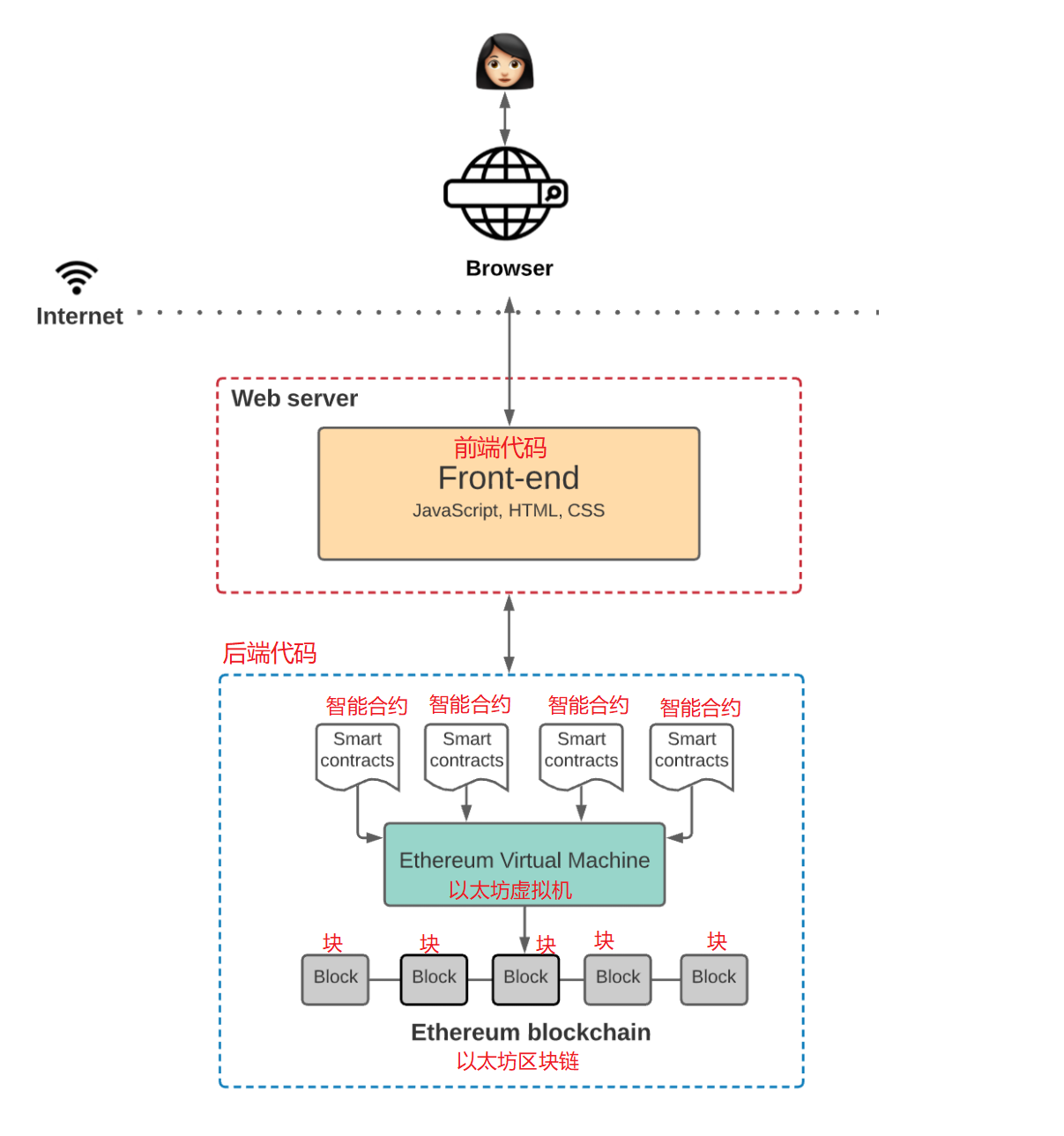
所以 Web 3.0应用架构中包含:
So the Web 3.0 application architecture includes:
以太坊区块链,经常被称为“世界计算机”,因为它可以一个可以被全世界所访问,由无数节点组成并共同维护的状态机。
它被设计为可以被任何人访问和编写,于是,也就无法被任何人所拥有,而只能共同拥有。
另外,一条很重要的规则是,区块链上的数据无法被修改,只能被增加。也就是说,我们只能往区块链上增加数据,而不能删除或者修改原数据。
The Ether block chain, often referred to as the “world computer”, is a state machine that can be accessed around the world, made up of numerous nodes and maintained together.
is designed to be accessed and written by anyone, so it cannot be owned by anyone but by everyone.
Also, an important rule is that data on the block chain cannot be modified, but only increased. That is, we can only add data to the block chain and not delete or modify the original data.
智能合约是运行在区块链上的代码,它定义了区块链上状态变化的逻辑。这些代码通常使用高级语言编写,例如Solidity或者Vyper。
A smart contract is the code that runs on the block chain, which defines the logic of the change of status in the block chain. These codes are usually written in advanced languages, such as Solidity or Vyper.
这些代码存储在区块链上,可以被任何人访问和审查。
These codes are stored on the block chain and can be accessed and reviewed by anyone.
示例
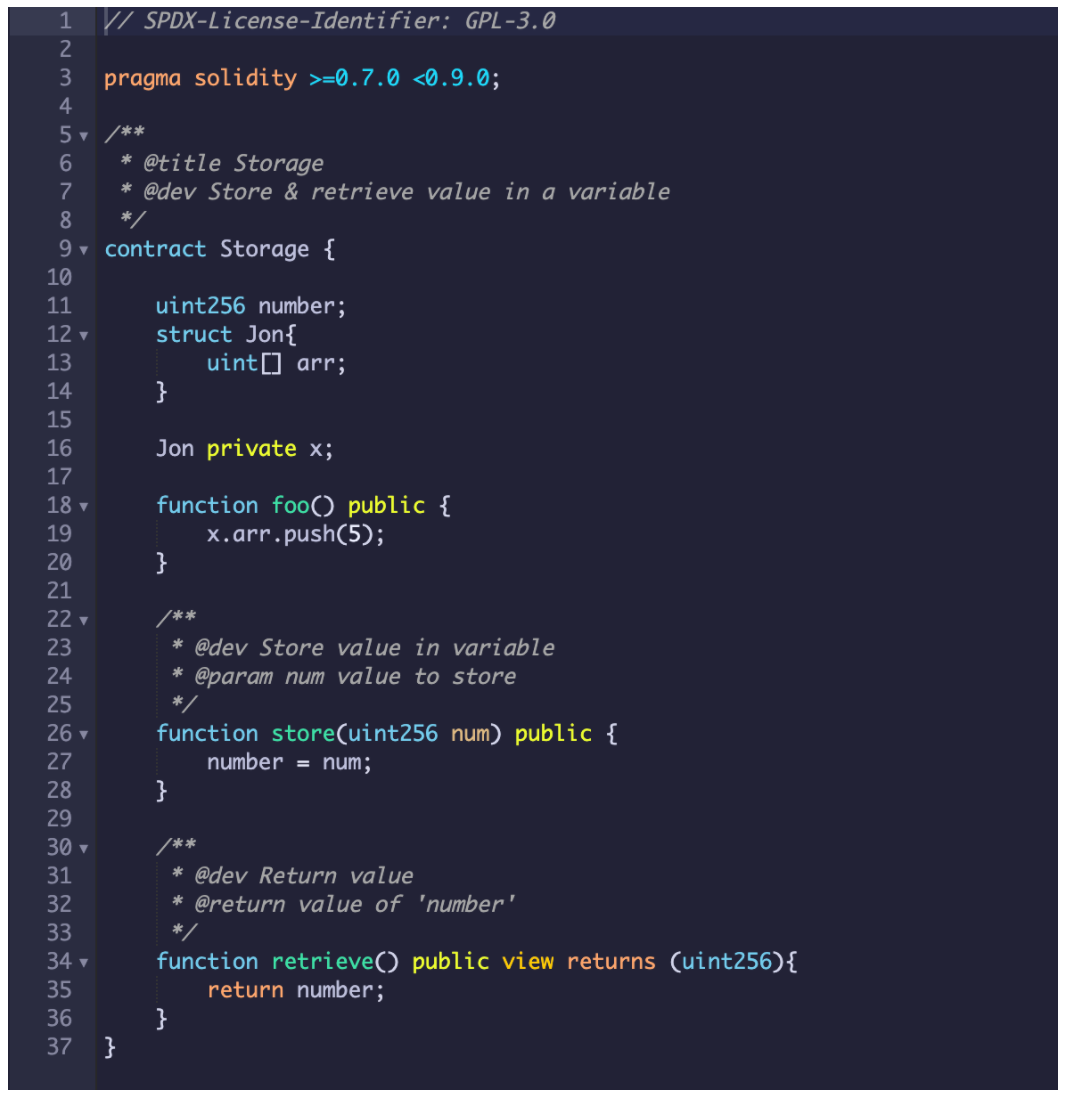
Example

以太坊虚拟机用来执行智能合约的代码。智能合约需要被编译成字节码才能在以太坊虚拟机上运行。
The code used to execute smart contracts is used as an Ether's virtual machine.
Web 3.0的前端代码负责用户交互,并与通过智能合约定义的业务逻辑进行交互。
Web 3.0 front-end code is responsible for user interaction and interaction with business logic defined through smart contracts.
但是真实情况是,这部分要比图上画的要复杂的多。
But the truth is, this part is more complicated than the picture.
注意,可能是由于以太坊作为是区块链的一个典型代表,所以,原文从这里开始经常把以太坊和区块链经常混着用。
在以太坊的网络上,任何一个节点都包含以太坊状态机的所有状态,包括代码,以及所有智能合约的相关数据。任何事务在虚拟机上的执行请求,都会被广播到网络中的其他节点中。
所以,当我们想要访问区块链上的数据时,我们需要与其中任意一个节点进行交互。然后一个所谓的“矿工”会负责执行我们的请求,并把最终状态传播到整个网络上。
Note, perhaps, because Tai Pa is a typical representative of the block chain, the original text often mixes it with the block chain from here.
On the Ether network, any node contains all the state of the Ether, including the code, and all the data related to the smart contract. Any execution request on the virtual machine will be broadcast to other nodes of the network.
So, when we want to access the data on the block node, we need to interact with any of them. Then a so-called miner will execute our request and transmit the final state to the entire network.
广播一个新事务请求有两种方式:
There are two ways to broadcast a request for a new business:
- 1). 自己搭建一个运行以太坊区块链软件的节点
- 2). 使用第三方服务,例如 Infura, Alchemy, 或者 QuickNode。
使用第三方是更经济的方式,因为自己搭建以太坊节点需要花费很多天的时间,因为有大量的数据需要同步,而且这些数据会越来越多。
The use of third parties is a more economical way, as it takes a lot of days to set up a portal on its own, because there is a great deal of data that needs to be synchronized and more and more.
这些第三方服务,被称为节点供应商 Provider。
These third-party services are known as node supplier Provider.
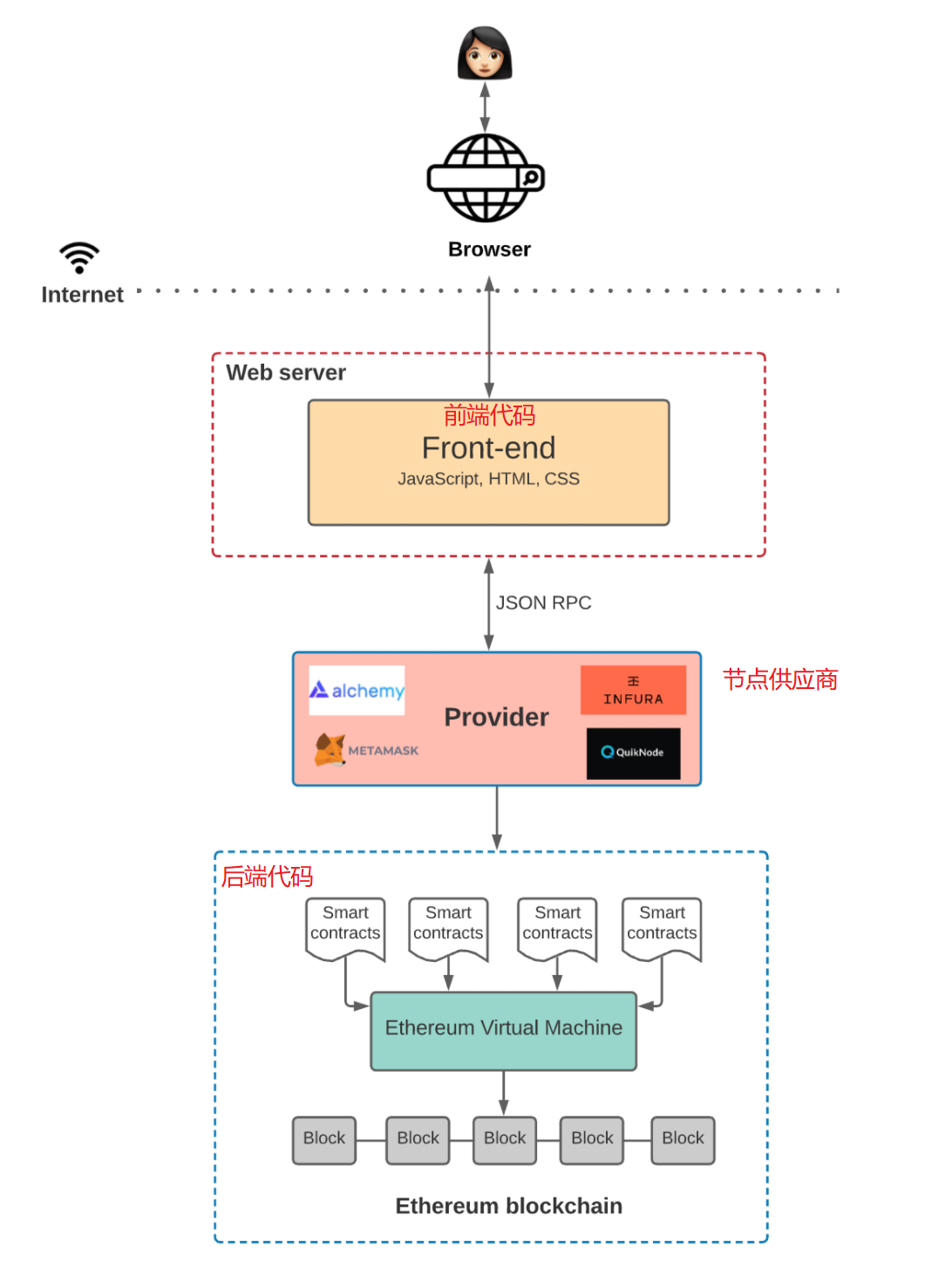
所有的以太坊客户端都通过JSON-RPC这种统一方式来进行交换数据。
All users exchange data through a unified approach such as JSON-RPC.
一旦我们通过节点供应商连接到上了区块链网络,我们就可以访问区块链上的所有数据了。
但是,如果想要往区块链上写入状态,在向区块链提交这个事务之前,则还需要做一件事:用你的私钥对这个事务进行签名。
Once we connect through the node supplier to the block chain network, we can access all the data on the block chain.
But if you want to write to the block chain state, before you submit this matter to the block chain, there is one more thing that needs to be done: to sign it with your private key.
以区块链博客应用为例,用户通常可以随意浏览博客文章,但是,如果想要发布新文章,则需要对这个发布文章的事务进行签名,否则这个事务将不被受理。
In the case of block-link blogs, for example, users are usually free to browse on blog articles, but if they want to publish a new article, it is necessary to sign the matter, otherwise the matter will not be heard.
对事务进行签名,就是Metamask这个工具做的工作:签名工具。
The signature of the transaction is the work done by the tool
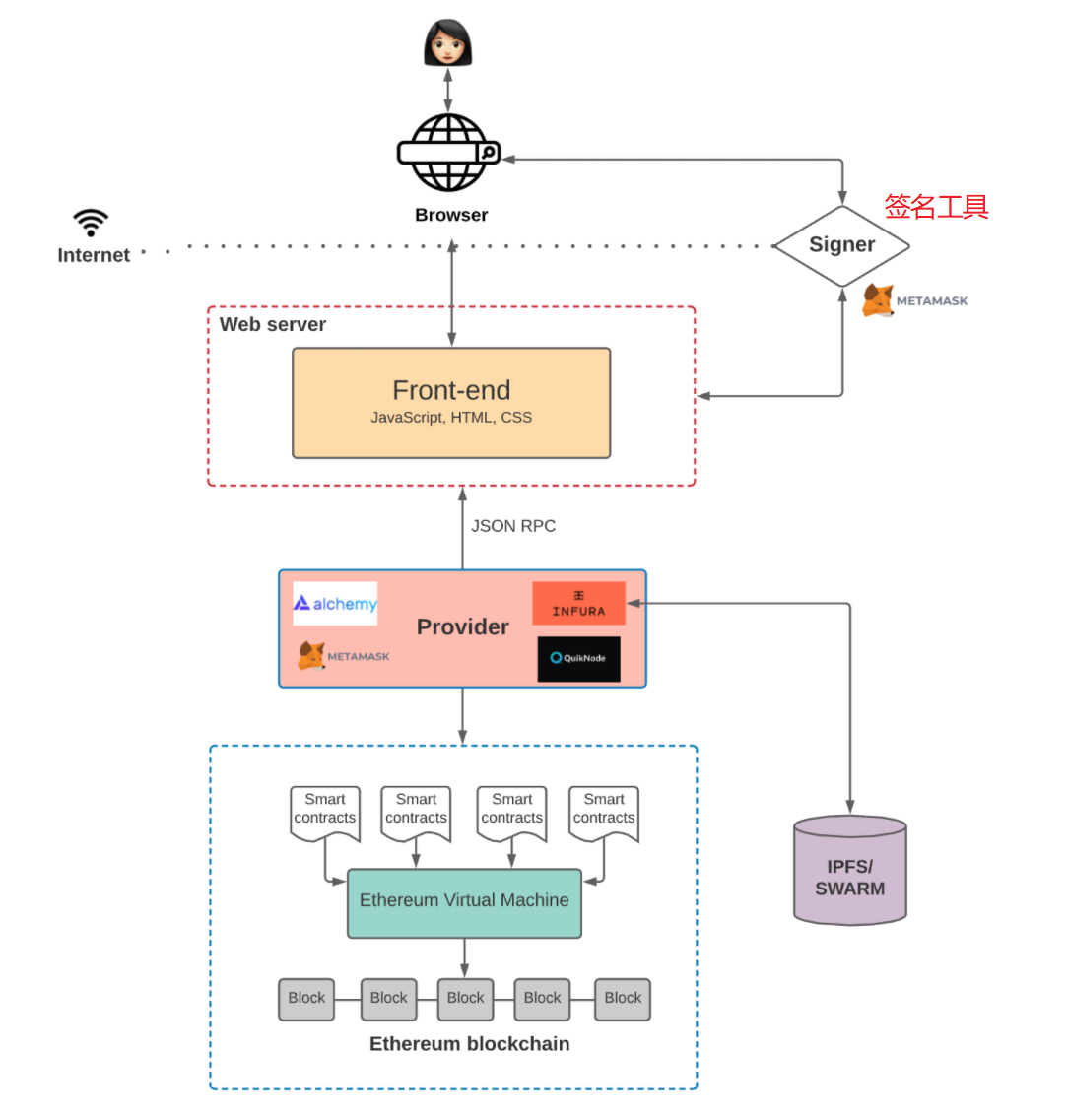
在这个图中,前端代码还没有被存储在区块链中,它依然可以像以前一样,部署在亚马逊的AWS或者阿里云上,但是,这样就不能成为一个彻底的非中心化应用。
In this map, the front-end code has not been stored in the block chain, and it can still be deployed on AWS or Ali Clouds in the Amazon, as it used to be, but it cannot be a complete `strong' decentralized application
所以,还需要一个非中心化的存储方案,例如IPFS 或者 Swarm。
So there's also a need for a non-centralized storage program, such as IPFS or Swarm.
现在,我们的非中心化软件架构变成了这样:
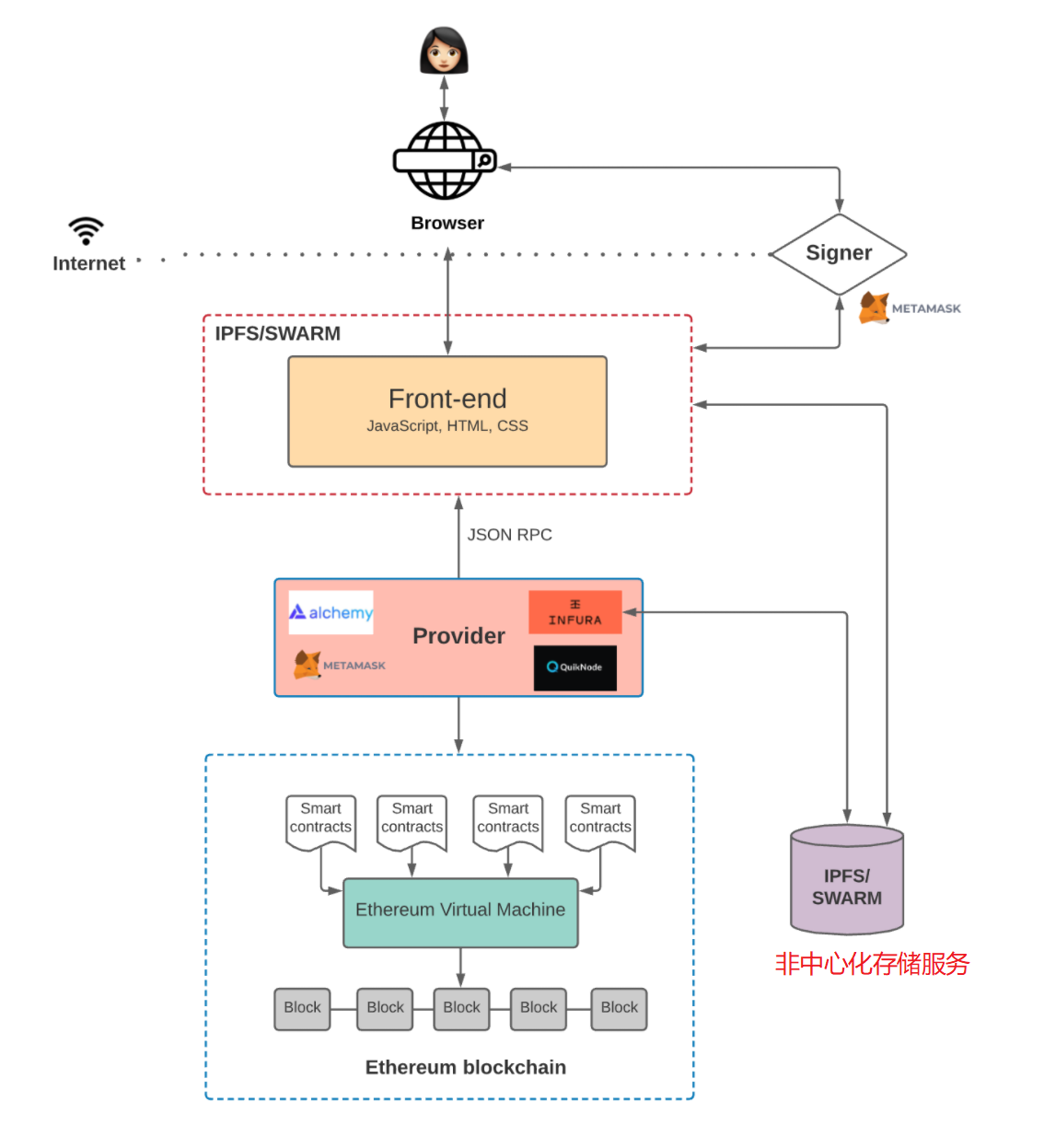
Now, our decentralized software architecture becomes this:

讲完如何通过智能合约向区块链写数据,那么该如何查询智能合约的数据呢?有两种主流方式:
How do you search the data from the smart contracts when you finish writing data to block chains through smart contracts? There are two main ways:
我们可以监听智能合约的事件。通过在智能合约代码中编写相应的事件发布逻辑,前端代码可以获取到对应的事件,并进行相应处理。
这种方法有个很大的缺陷:由于区块链不允许修改数据,包括智能合约代码,一旦智能合约被部署,如果想补充新的事件,就只能重新部署一个新智能合约,并重新监听。
We can listen to smart contract events. By developing the corresponding event release logic in the smart contract code, the front-end code can capture the corresponding event and deal with it accordingly.
This approach has a major flaw: once the smart contract is deployed, if you want to add a new event, you can only redeploy a new smart contract and retrace it.
The Graph 图查询接口,是一种为了方便查询区块链数据的离链索引方案。我们可以定义需要索引的智能合约,相关的事件,以及如何进行数据转换。通过这种方式,区块链的数据就被索引起来,然后再通过GraphQL语言来进行查询。
In this way, the data in the block chain is indexed and then searched through the GraphQL language.
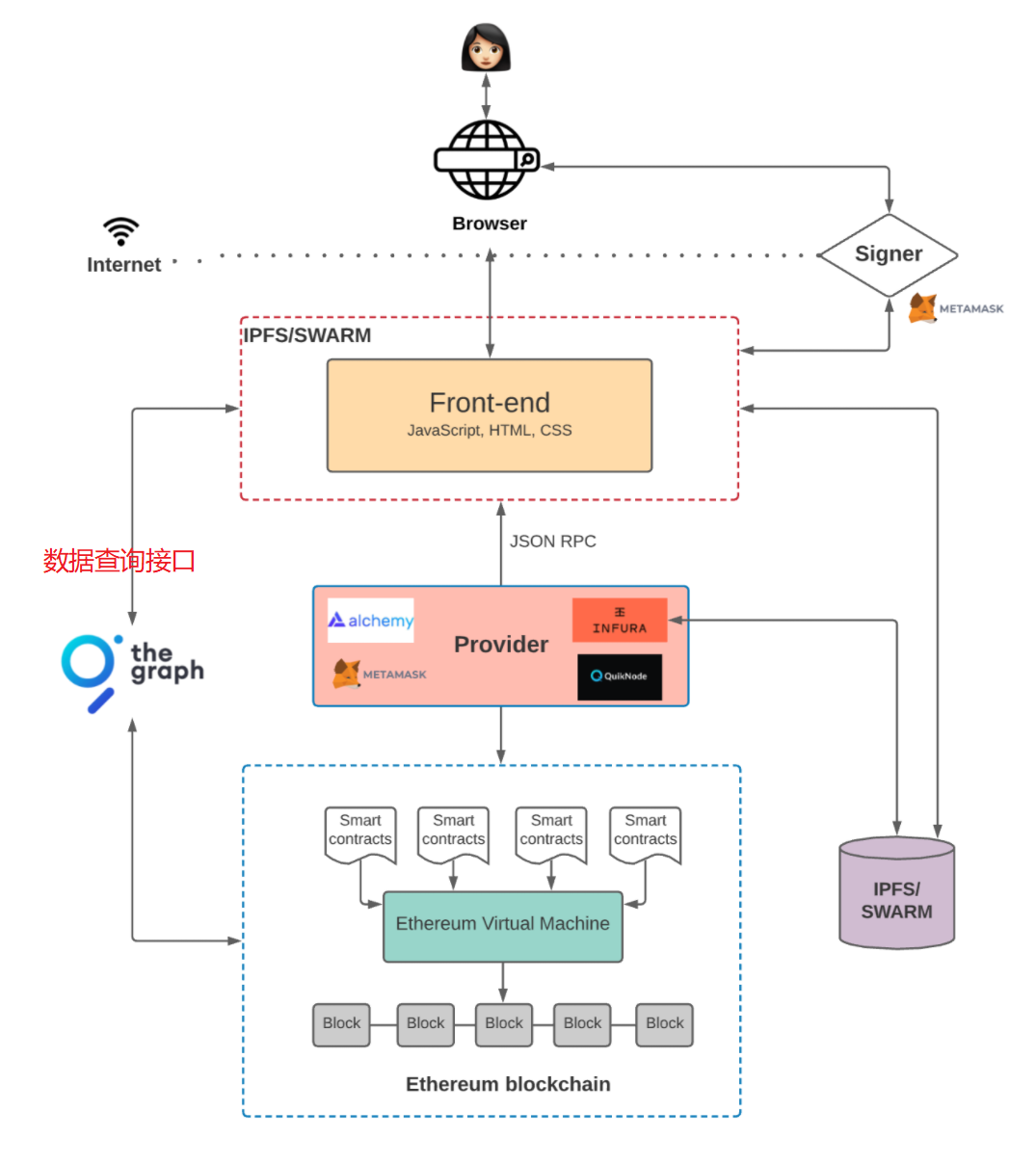
在以太坊网络上构建非中心化应用,需要花费大量的费用成本,而且体验很差(主要指要将数据同步到所有的节点需要花费比较长的时间)。
一个比较流行的方案是Ploygon,L2 规模化方案。这种方案通过在“侧链”而非主链上执行事务,然后定期将状态同步到主链,从而大大降低了成本提高了速度。
The construction of decentralized applications on the Taiyo network is costly and difficult to experience (mainly to synchronize data to all nodes takes longer).
A more popular option is Ploygon, L2 scalation. This option significantly reduces the speed of costs by implementing services on the “side chain” rather than on the main chain, and then regularly synchronizing the status to the main chain.
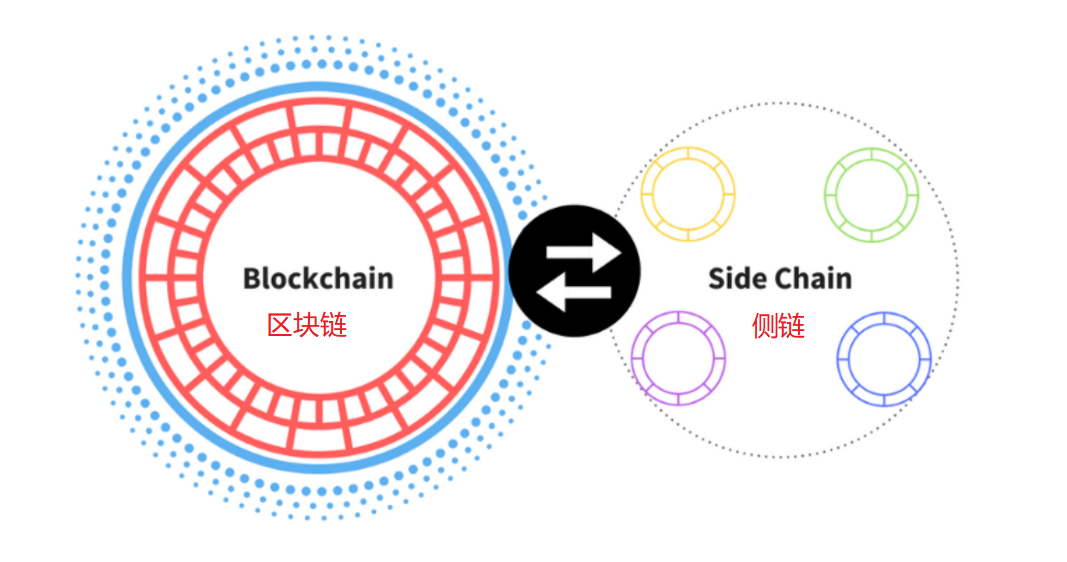
类似的方案还有 Optimistic Rollups和zkRollups。
Similar programmes include Optimistic Rollups and zkRollups.
现在,我们的架构变成了这样子:
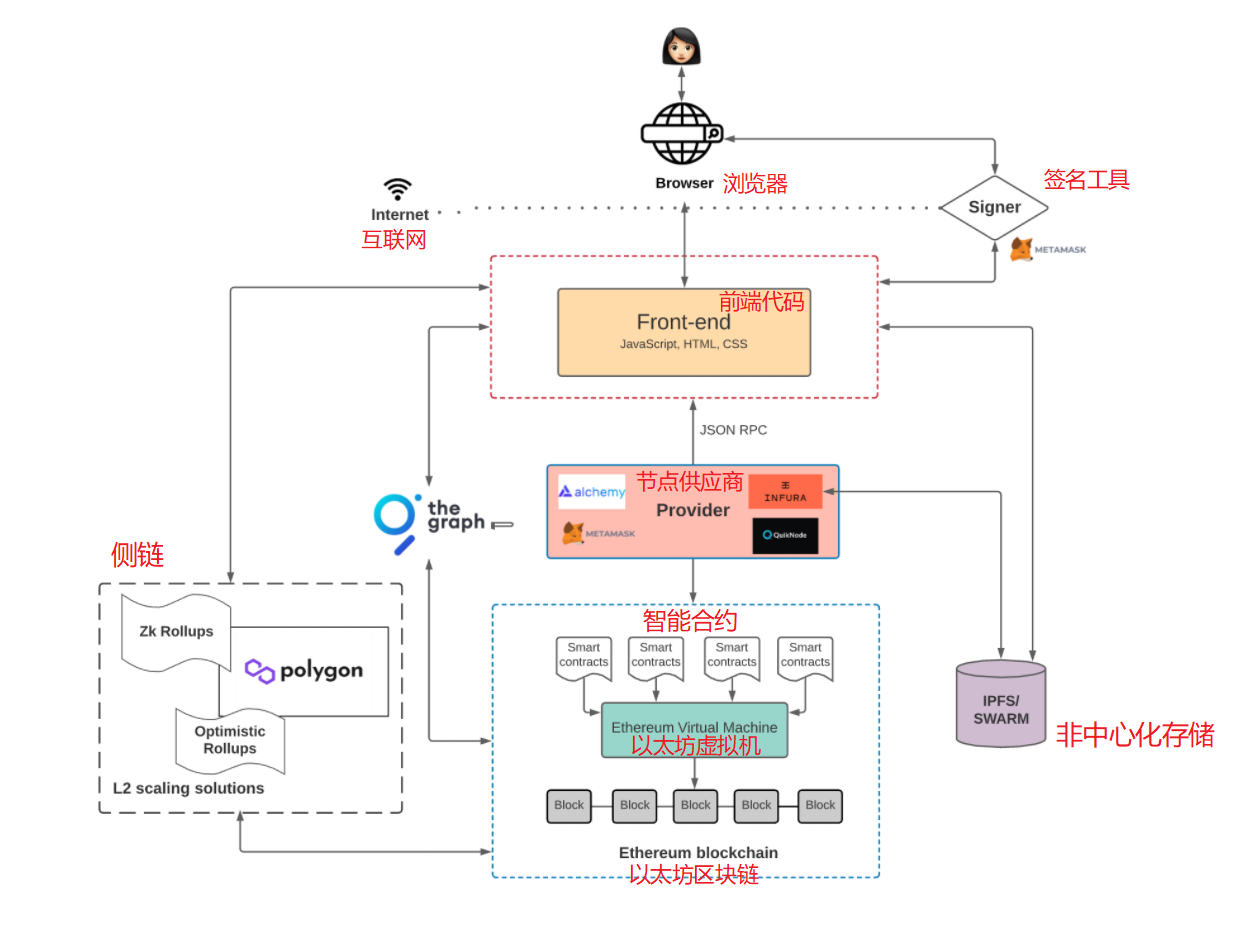
Now, our structure becomes this:

为了降低非中心化应用的开发难度,一些开发框架正在被开发出来。例如,Hardhat就是一个方便以太坊开发者创建、部署和测试智能合约的框架。通过Hardhat的网络,开发者甚至可以把智能合约部署在本地而不需要部署到线上环境。它还提供了插件系统和其他工具等来提升开发体验。
In order to reduce the difficulty of developing decentralized applications, some development frameworks are being developed. For example, Hardhat is a framework that facilitates the creation, deployment and testing of smart contracts by Pacific developers. Through Hardhat’s network, developers can even deploy smart contracts locally without having to deploy to the online environment.
以上。
Over.
本文中,我特意将两个词做了个人倾向的翻译:
In this paper, I specifically translated the two words into a personalized translation:
- decentralize: 翻译为“非中心化”而不是通常的“去中心化”
- transaction:翻译“事务”而非“交易”
希望可以更冷静地看待当前的区块链、Web3.0以及元宇宙的相关技术。
技术只是工具,可以用来造福社会,也可以用来割韭菜。

聊一聊IT男眼中的世界
注册有任何问题请添加 微信:MVIP619 拉你进入群

打开微信扫一扫
添加客服
进入交流群











发表评论